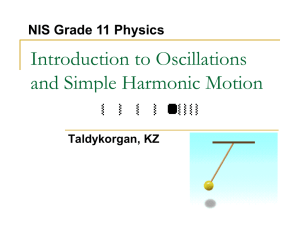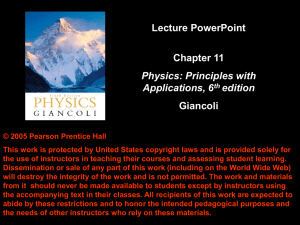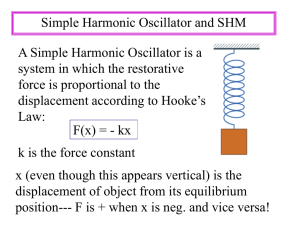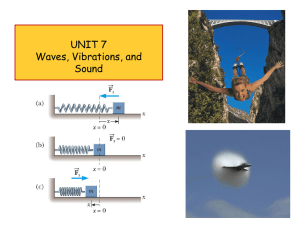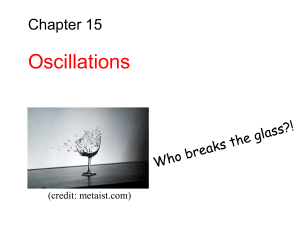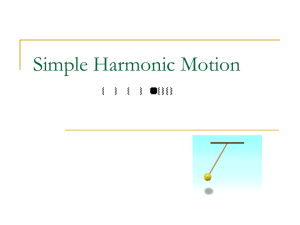Simple Harmonic Motion
advertisement
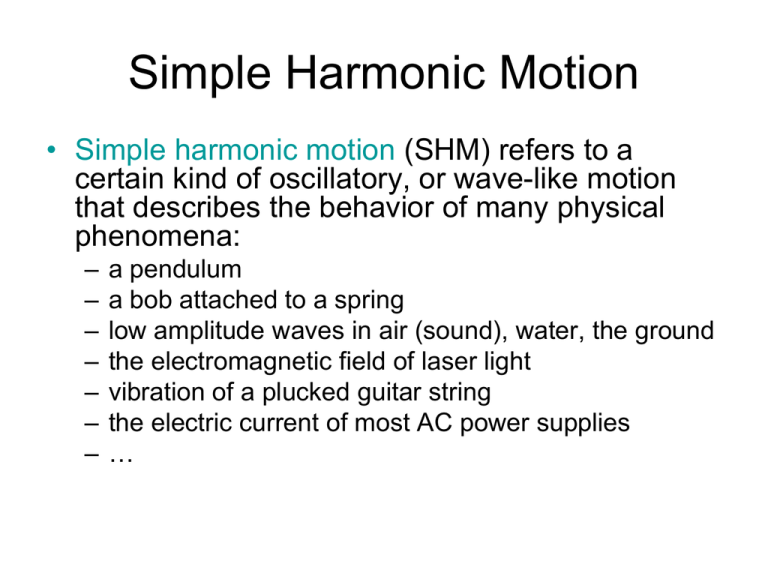
Simple Harmonic Motion • Simple harmonic motion (SHM) refers to a certain kind of oscillatory, or wave-like motion that describes the behavior of many physical phenomena: – – – – – – – a pendulum a bob attached to a spring low amplitude waves in air (sound), water, the ground the electromagnetic field of laser light vibration of a plucked guitar string the electric current of most AC power supplies … SHM Position, Velocity, and Acceleration Simple Harmonic Motion Periodic Motion: any motion of system which repeats itself at regular, equal intervals of time. Simple Harmonic Motion Simple Harmonic Motion • Equilibrium: the position at which no net force acts on the particle. • Displacement: The distance of the particle from its equilibrium position. Usually denoted as x(t) with x=0 as the equilibrium position. • Amplitude: the maximum value of the displacement with out regard to sign. Denoted as xmax or A. The period and frequency of a wave • • the period T of a wave is the amount of time it takes to go through 1 cycle the frequency f is the number of cycles per second – the unit of a cycle-per-second is commonly referred to as a hertz (Hz), after Heinrich Hertz (1847-1894), who discovered radio waves. • frequency and period are related as follows: 1 f T • t Since a cycle is 2p radians, the relationship between frequency and angular frequency is: 2pf T • http://www.physics.uoguelph.ca/tutorials/s hm/Q.shm.html Here is a ball moving back and forth with simple harmonic motion (SHM): Its position x as a function of time t is: where A is the amplitude of motion : the distance from the centre of motion to either extreme T is the period of motion: the time for one complete cycle of the motion. Restoring Force How does the restoring force act with respect to the displacement from the equilibrium position? F is proportional to -x Simple harmonic motion is the motion executed by a particle of mass m subject to a force that is proportional to the displacement of the particle but opposite in sign. Springs and SHM • Attach an object of mass m to the end of a spring, pull it out to a distance A, and let it go from rest. The object will then undergo simple harmonic motion: x(t ) A cos(t ) v(t ) A sin(t ) a(t ) A2 cos(t ) • What is the angular frequency in this case? – Use Newton’s 2nd law, together with Hooke’s law, and the above description of the acceleration to find: k m Springs and Simple Harmonic Motion Equations of Motion Conservation of Energy allows a calculation of the velocity of the object at any position in its motion… Conservation of Energy For A Spring in Horizontal Motion E = E = Kinetic + Elastic Potential ½ mv2 + ½ kx2 = Constant • At maximum displacement, velocity is zero and all energy is elastic potential, so total energy is equal to ½ kA2 • To find the velocity @ any displacement… do conservation of Energy… @ some point at max displacement • ½ mv2 + ½ kx2 = 1/2kA2 • Solving for v k 2 2 v A x m • This is wonderful but what about time??! v=dx/dt and separate variables! dx dt k A2 x 2 m dx A sin dt k t c m k 2 2 v A x m SHM Solution... • Drawing of A cos(t ) • A = amplitude of oscillation T = 2p/ A 2p p A p 2p SHM Solution... • Drawing of A cos(t + ) 2p p p 2p SHM Solution... • Drawing of A cos(t - p/2) = p/2 A 2p p p = A sin(t)! 2p 1989.M3 3.0 m/s, 0.63 s, 0.098 m, 0.41 m, 0.31 m 1989M3. A 2-kilogram block is dropped from a height of 0.45 m above an uncompressed spring, as shown above. The spring has an elastic constant of 200 N per meter and negligible mass. The block strikes the end of the spring and sticks to it. a. Determine the speed of the block at the instant it hits the end of the spring. 3 m/s b. Determine the period of the simple harmonic motion that ensues. 0.63s c. Determine the distance that the spring is compressed at the instant the speed of the block is maximum. 0.098 m d. Determine the maximum compression of the spring. 0.41 m e. Determine the amplitude of the simple harmonic motion. 0.31 m SHM So Far • The most general solution is x = A cos(t + ) where A = amplitude = angular frequency = phase • For a mass on a spring k m – The frequency does not depend on the amplitude!!! – We will see that this is true of all simple harmonic motion! Pendulums • When we were discussing the energy in a simple harmonic system, we talked about the ‘springiness’ of the system as storing the potential energy • But when we talk about a regular pendulum there is nothing ‘springy’ – so where is the potential energy stored? The Simple Pendulum • As we have already seen, the potential energy in a simple pendulum is stored in raising the bob up against the gravitational force • The pendulum bob is clearly oscillating as it moves back and forth – but is it exhibiting SHM? • We can see that the restoring force is: F = -mg sinθ If we assume that the angle θ is small, then sinθ ~ θ and our equation becomes F ~ -mgθ = - mgs/L = - (mg/L)s F ~ -mgθ = - mgs/L = - (mg/L)s dividing both sides by m, a = -(g/L)s. Equate to a = -ω 2 x, and ω = (g/L)1/2 The Physical Pendulum • Now suppose that the mass is not all concentrated in the bob? • In this case the equations are exactly the same, but the restoring force acts through the center of mass of the body (C in the diagram) which is a distance h from the pivot point • Going back to our definition of torque, we can see that the restoring force is producing a torque around the pivot point of: LFg sin •where L is the moment arm of the applied force The Simple Pendulum If we substitute τ = Iα, we get: LFg sin I • This doesn’t appear too promising until we make the following assumption – • that θ is small… • If θ is small we can use the approximation that sin θ θ • (as long as we remember to express θ in radians) The Physical Pendulum • Making the substitution we then get: LFg I which we can then rearrange to get: mgL I which is the angular equivalent to a = -ω 2 x •So, we can reasonably say that the motion of a pendulum is approximately SHM if the maximum angular amplitude is small The Physical Pendulum • Making the substitution we then get: LFg I which we can then rearrange to get: mgL I which is the angular equivalent to a = -ω 2 x •So, we can reasonably say that the motion of a pendulum is approximately SHM if the maximum angular amplitude is small The Physical Pendulum • So we go back to our previous equation for the period and replace L with h to get: I T 2p mgh The Simple Pendulum The period of a pendulum is given by: T 2p I mgL where I is the moment of inertia of the pendulum •If all of the mass of the pendulum is concentrated in the bob, then I = mL2 and we get: T 2p L g An Angular Simple Harmonic Oscillator • The figure shows an angular version of a simple harmonic oscillator • In this case the mass rotates around it’s center point and twists the suspending wire • This is called a torsional pendulum with torsion referring to the twisting motion Torsional Oscillator • If the disk is rotated through an angle (in either direction) of θ, the restoring torque is given by the equation: Comparing with F kx Which gives T 2p I Where has replaced k and I has replaced m Sample Problem A uniform bar with mass m lies symmetrically across two rapidly rotating, fixed rollers, A and B, with distance L = 2.0 cm between the bar’s center of mass and each roller. The rollers slip against the bar with coefficient of friction µk = 0.40. Suppose the bar is displaced horizontally by a distance x and then released. What is the angular frequency of the resulting horizontal motion of the bar? ω = 14 rad/s Sample Problem 1 • A 1 meter stick swings about a pivot point at one end at a distance h from its center of mass • What is the period of oscillation? A penguin dives from a uniform board that is hinged at the left and attached to a spring at the right. The board has length L = 2.0 m and mass m = 12 kg; the spring constant k = 1300 N/m. When the penguin dives, it leaves the board and spring oscillating with a small amplitude. Assume that the board is stiff enough not to bend, and find the period T of the oscillations. T = 0.35 s



